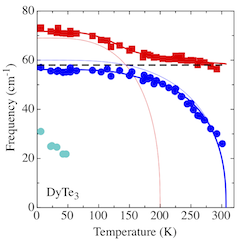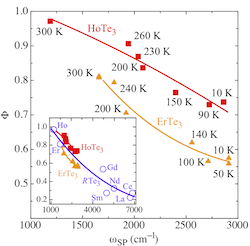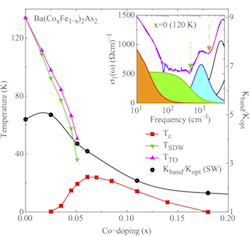Highlights 2010
Raman scattering evidence for a cascade-like evolution of the charge-density-wave collective amplitude mode
The two-dimensional rare-earth tri-tellurides undergo a unidirectional charge-density-wave (CDW) transition at high temperature and, for the heaviest members of the series, a bidirectional one at low temperature. Raman scattering experiments as a function of temperature on DyTe3 and on LaTe3 at 6 GPa provide a clear-cut evidence for the
emergence of the respective collective CDW amplitude excitations. In the unidirectional CDW phase, we discover that the amplitude mode develops as a succession of two mean-field, BCS-like transitions with different critical temperatures, which we associate with the presence of two adjacent Te planes in the structure.
Related paper
Temperature dependence of the excitation spectrum in the charge-density-wave ErTe3 and HoTe3 system
We provide optical reflectivity data collected over a broad spectral range and as a function of temperature on the ErTe3 and HoTe3 materials, which undergo two consecutive charge-density-wave (CDW) phase transitions at TCDW1= 265 and 288 K and at TCDW2= 157 and 110 K, respectively. We observe the temperature dependence of both the Drude component, due to the itinerant charge carriers,
and the single-particle peak, ascribed to the charge-density-wave gap excitation. The CDW gap progressively opens while the metallic component gets narrow with decreasing temperature. An important fraction of the whole Fermi surface seems to be affected by the CDW phase transitions. It turns out that the temperature and the previously investigated pressure dependence of the most relevant CDW parameters share several common features and behaviors. Particularly, the order parameter of the CDW state is in general agreement with the predictions of the BCS theory.
Related paper
Charge dynamics of the Co-doped BaFe2As2
We report on a thorough optical investigation over a broad spectral range and as a function of temperature of the charge dynamics in Ba(Fe1-xCox)2As2 compounds for Co-doping ranging between 0 and 18%. For the parent compound as well as for x = 0.025 we observe the opening of a pseudogap, due to the spin-density-wave phase transition and inducing a
reshuffling of spectral weight from low to high frequencies. For compounds with 0.051 < x < 0.11 we detect the superconducting gap, while at x = 0.18 the material stays metallic at all temperatures. We describe the effective metallic contribution to the optical conductivity with two (narrow and broad) Drude terms and extract the respective scattering rates. We establish that the dc transport properties in the normal phase are dominated by the narrow Drude term for 0 < x < 0.051 and by the broad one for 0.061 < x < 0.18, respectively. Finally through spectral weight arguments, we give clear-cut evidence for moderate electronic correlations for 0 < x < 0.061, which then crossover to values appropriate for a regime of weak interacting and nearly-free electron metals for x > 0.11.



